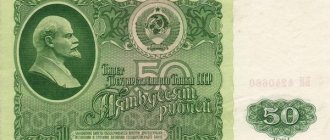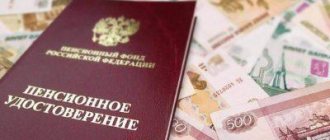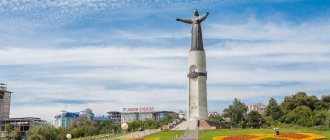At the end of 2021, the average (expected) life expectancy in Russia reached another historical maximum and amounted to 73.4 years.
[2] In 2021, according to the Ministry of Health, it was lower - 72.9 years.[3] In 2021, according to Rosstat, this figure was 72.7 years. [4]
In 2015, Russia broke the average life expectancy record achieved in the RSFSR - 71.4 years (for men - 65.9 years, for women - 76.7 years). [5]
In 2021, after a long period of growth, life expectancy dropped to 71.5 years (according to preliminary data from Rosstat). [6]
This is huge progress compared to the 1990s. However, Russia is still several years behind Western countries such as the USA, Germany or Japan in life expectancy.[1] The state of medicine in Russia has improved dramatically, citizens began to lead a healthier lifestyle (the quality of nutrition has increased, alcohol consumption has decreased, more people began to play sports, and so on). However, much work remains to be done to further improve the health and safety of Russian citizens.
Dynamics of life expectancy in Russia
Rosstat data
Source - Rosstat data as of August 17, 2021
| Total | Urban population | Rural population | |||||||
| Years | Both sexes | Men | Women | Both sexes | Men | Women | Both sexes | Men | Women |
| 1896—1897[2] | 30,54 | 29,43 | 31,69 | 29,77 | 27,62 | 32,24 | 30,63 | 29,66 | 31,66 |
| 1926—1927[3] | 42,93 | 40,23 | 45,61 | 43,92 | 40,37 | 47,50 | 42,86 | 40,39 | 45,30 |
| 1958—1959 | 67,91 | 62,99 | 71,45 | 67,92 | 63,03 | 71,48 | 67,84 | 62,86 | 71,30 |
| 1961—1962 | 68,75 | 63,78 | 72,38 | 68,69 | 63,86 | 72,48 | 68,62 | 63,40 | 72,33 |
| 1962—1963 | 69,38 | 64,44 | 73,02 | 69,21 | 64,46 | 72,74 | 69,29 | 63,89 | 73,14 |
| 1964—1965 | 69,61 | 64,60 | 73,34 | 69,46 | 64,70 | 73,02 | 69,42 | 63,78 | 73,49 |
| 1965—1966 | 69,50 | 64,32 | 73,41 | 69,44 | 64,59 | 73,14 | 69,14 | 63,32 | 73,49 |
| 1966—1967 | 69,45 | 64,16 | 73,49 | 69,45 | 64,50 | 73,24 | 68,97 | 63,13 | 73,52 |
| 1967—1968 | 69,34 | 63,92 | 73,54 | 69,37 | 64,33 | 73,31 | 68,91 | 62,77 | 73,56 |
| 1968—1969 | 69,06 | 63,46 | 73,50 | 69,12 | 63,95 | 73,23 | 68,53 | 62,01 | 73,58 |
| 1969—1970 | 68,81 | 63,15 | 73,39 | 68,97 | 63,57 | 73,32 | 68,23 | 62,11 | 73,20 |
| 1970—1971 | 68,93 | 63,21 | 73,55 | 68,51 | 63,76 | 73,47 | 68,13 | 61,78 | 73,39 |
| 1971—1972 | 68,95 | 63,21 | 73,60 | 69,33 | 63,94 | 73,66 | 67,88 | 61,36 | 73,26 |
| 1972—1973 | 68,88 | 63,21 | 73,49 | 69,33 | 64,02 | 73,60 | 67,61 | 61,07 | 73,02 |
| 1973—1974 | 68,90 | 63,16 | 73,58 | 69,38 | 64,08 | 73,67 | 67,40 | 60,62 | 73,07 |
| 1974—1975 | 68,60 | 62,78 | 73,41 | 69,16 | 63,80 | 73,53 | 66,79 | 59,68 | 72,80 |
| 1975—1976 | 68,13 | 62,32 | 73,03 | 68,75 | 63,41 | 73,22 | 66,14 | 58,85 | 72,38 |
| 1976—1977 | 67,95 | 62,00 | 73,11 | 68,53 | 63,14 | 73,21 | 65,75 | 58,18 | 72,36 |
| 1977—1978 | 67,85 | 61,83 | 73,17 | 68,49 | 63,11 | 73,28 | 65,51 | 57,69 | 72,49 |
| 1978—1979 | 67,72 | 61,66 | 73,11 | 68,17 | 62,46 | 73,17 | 66,32 | 59,62 | 72,61 |
| 1979—1980 | 67,54 | 61,45 | 73,00 | 68,04 | 62,28 | 73,09 | 65,99 | 59,31 | 72,39 |
| 1980—1981 | 67,61 | 61,53 | 73,09 | 68,09 | 62,39 | 73,18 | 66,02 | 59,30 | 72,47 |
| 1981—1982 | 68,01 | 61,99 | 73,47 | 68,50 | 62,81 | 73,54 | 66,33 | 59,67 | 72,84 |
| 1982—1983 | 68,25 | 62,27 | 73,63 | 68,72 | 63,10 | 73,67 | 66,54 | 59,83 | 73,04 |
| 1983—1984 | 67,93 | 62,00 | 73,31 | 68,43 | 62,87 | 73,38 | 66,11 | 59,41 | 72,70 |
| 1984—1985 | 68,08 | 62,31 | 73,32 | 68,59 | 63,13 | 73,42 | 66,26 | 59,77 | 72,63 |
| 1985—1986 | 69,26 | 63,83 | 73,99 | 69,61 | 64,46 | 74,00 | 67,86 | 61,76 | 73,55 |
| 1986—1987 | 70,13 | 64,91 | 74,55 | 70,32 | 65,38 | 74,44 | 69,09 | 63,21 | 74,40 |
| 1988 | 69,90 | 64,80 | 74,43 | 70,09 | 65,37 | 74,20 | 68,72 | 62,71 | 74,37 |
| 1989 | 69,57 | 64,21 | 74,47 | 69,89 | 64,75 | 74,49 | 68,45 | 62,60 | 74,19 |
| 1990 | 69,19 | 63,73 | 74,30 | 69,55 | 64,31 | 74,34 | 67,97 | 62,03 | 73,95 |
| 1991 | 69,01 | 63,46 | 74,27 | 69,39 | 64,06 | 74,33 | 67,73 | 61,70 | 73,87 |
| 1992 | 67,89 | 62,02 | 73,75 | 68,20 | 62,48 | 73,80 | 66,87 | 60,67 | 73,45 |
| 1993 | 65,14 | 58,97 | 71,88 | 65,42 | 59,25 | 71,97 | 64,28 | 57,94 | 71,51 |
| 1994 | 63,98 | 57,59 | 71,18 | 64,24 | 57,88 | 71,29 | 63,17 | 56,75 | 70,82 |
| 1995 | 64,52 | 58,12 | 71,59 | 64,70 | 58,30 | 71,64 | 63,99 | 57,64 | 71,40 |
| 1996 | 65,89 | 59,75 | 72,49 | 66,31 | 60,22 | 72,70 | 64,67 | 58,44 | 71,85 |
| 1997 | 66,64 | 60,75 | 72,89 | 67,19 | 61,43 | 73,10 | 65,10 | 58,94 | 72,29 |
| 1998 | 67,02 | 61,30 | 72,93 | 67,46 | 61,82 | 73,13 | 65,77 | 59,90 | 72,32 |
| 1999 | 65,93 | 59,93 | 72,38 | 66,39 | 60,41 | 72,65 | 64,62 | 58,63 | 71,55 |
| 2000 | 65,34 | 59,03 | 72,26 | 65,69 | 59,35 | 72,46 | 64,34 | 58,14 | 71,66 |
| 2001 | 65,23 | 58,92 | 72,17 | 65,57 | 59,23 | 72,37 | 64,25 | 58,07 | 71,57 |
| 2002 | 64,95 | 58,68 | 71,90 | 65,40 | 59,09 | 72,18 | 63,68 | 57,54 | 71,09 |
| 2003[4] | 64,84 | 58,53 | 71,85 | 65,36 | 59,01 | 72,20 | 63,34 | 57,20 | 70,81 |
| 2004[4] | 65,31 | 58,91 | 72,36 | 65,87 | 59,42 | 72,73 | 63,77 | 57,56 | 71,27 |
| 2005[4] | 65,37 | 58,92 | 72,47 | 66,10 | 59,58 | 72,99 | 63,45 | 57,22 | 71,06 |
| 2006[4] | 66,69 | 60,43 | 73,34 | 67,43 | 61,12 | 73,88 | 64,74 | 58,69 | 71,86 |
| 2007[4] | 67,61 | 61,46 | 74,02 | 68,37 | 62,20 | 74,54 | 65,59 | 59,57 | 72,56 |
| 2008[4] | 67,99 | 61,92 | 74,28 | 68,77 | 62,67 | 74,83 | 65,93 | 60,00 | 72,77 |
| 2009[4] | 68,78 | 62,87 | 74,79 | 69,57 | 63,65 | 75,34 | 66,67 | 60,86 | 73,27 |
| 2010[4] | 68,94 | 63,09 | 74,88 | 69,69 | 63,82 | 75,39 | 66,92 | 61,19 | 73,42 |
| 2011 | 69,83 | 64,04 | 75,61 | 70,51 | 64,67 | 76,10 | 67,99 | 62,40 | 74,21 |
| 2012 | 70,24 | 64,56 | 75,86 | 70,83 | 65,10 | 76,27 | 68,61 | 63,12 | 74,66 |
| 2013 | 70,76 | 65,13 | 76,30 | 71,33 | 65,64 | 76,70 | 69,18 | 63,75 | 75,13 |
| 2014[5] | 70,93 | 65,29 | 76,47 | 71,44 | 65,75 | 76,83 | 69,49 | 64,07 | 75,43 |
| 2015 | 71,39 | 65,92 | 76,71 | 71,91 | 66,38 | 77,09 | 69,90 | 64,67 | 75,59 |
| 2016 | 71,87 | 66,50 | 77,06 | 72,35 | 66,91 | 77,38 | 70,50 | 65,36 | 76,07 |
| 2017 | 72,70 | 67,51 | 77,64 | 73,16 | 67,90 | 77,96 | 71,38 | 66,43 | 76,66 |
| 2018 | 72,91 | 67,75 | 77,82 | 73,34 | 68,11 | 78,09 | 71,67 | 66,75 | 76,93 |
| 2019 | 73,34 | 68,24 | 78,17 | 73,72 | 68,56 | 78,41 | 72,21 | 67,36 | 77,39 |
Average life expectancy at birth in Russia (for the general population), 1959–2019, data from Rosstat and the World Bank
World Bank data
Source: World Bank data as of June 23, 2021.
| Year | Life expectancy (men, years) | Life expectancy (women, years) | Life expectancy (both sexes, years) |
| 1960 | 62,07 | 70,24 | 66,06 |
| 1961 | 62,58 | 70,82 | 66,60 |
| 1962 | 62,96 | 71,29 | 67,02 |
| 1963 | 63,22 | 71,67 | 67,34 |
| 1964 | 63,37 | 71,98 | 67,57 |
| 1965 | 63,43 | 72,22 | 67,72 |
| 1966 | 63,43 | 72,41 | 67,81 |
| 1967 | 63,39 | 72,56 | 67,86 |
| 1968 | 63,31 | 72,67 | 67,87 |
| 1969 | 63,21 | 72,76 | 67,87 |
| 1970 | 63,08 | 73,44 | 68,13 |
| 1971 | 63,24 | 73,77 | 68,38 |
| 1972 | 63,25 | 73,62 | 68,31 |
| 1973 | 63,28 | 73,56 | 68,30 |
| 1974 | 63,13 | 73,77 | 68,32 |
| 1975 | 62,48 | 73,23 | 67,72 |
| 1976 | 62,19 | 73,05 | 67,49 |
| 1977 | 61,83 | 73,20 | 67,38 |
| 1978 | 61,83 | 73,23 | 67,39 |
| 1979 | 61,49 | 73,02 | 67,11 |
| 1980 | 61,39 | 72,96 | 67,03 |
| 1981 | 61,62 | 73,19 | 67,26 |
| 1982 | 62,25 | 73,64 | 67,81 |
| 1983 | 62,16 | 73,42 | 67,65 |
| 1984 | 61,71 | 72,97 | 67,20 |
| 1985 | 62,73 | 73,24 | 67,86 |
| 1986 | 64,78 | 74,23 | 69,39 |
| 1987 | 64,84 | 74,27 | 69,44 |
| 1988 | 64,64 | 74,53 | 69,46 |
| 1989 | 64,24 | 74,35 | 69,18 |
| 1990 | 63,73 | 74,30 | 68,89 |
| 1991 | 63,45 | 73,75 | 68,47 |
| 1992 | 62,00 | 71,99 | 66,87 |
| 1993 | 58,97 | 71,20 | 64,94 |
| 1994 | 57,55 | 71,73 | 64,47 |
| 1995 | 58,12 | 71,59 | 64,69 |
| 1996 | 59,62 | 72,40 | 65,85 |
| 1997 | 60,85 | 72,84 | 66,70 |
| 1998 | 61,22 | 73,13 | 67,03 |
| 1999 | 59,87 | 72,40 | 65,98 |
| 2000 | 59,03 | 72,26 | 65,48 |
| 2001 | 58,92 | 72,17 | 65,38 |
| 2002 | 58,68 | 71,90 | 65,13 |
| 2003 | 58,56 | 71,86 | 65,05 |
| 2004 | 58,91 | 72,36 | 65,47 |
| 2005 | 58,92 | 72,47 | 65,53 |
| 2006 | 60,43 | 73,34 | 66,73 |
| 2007 | 61,46 | 74,02 | 67,59 |
| 2008 | 61,92 | 74,28 | 67,95 |
| 2009 | 62,87 | 74,79 | 68,69 |
| 2010 | 63,09 | 74,88 | 68,84 |
| 2011 | 64,04 | 75,61 | 69,68 |
| 2012 | 64,56 | 75,86 | 70,07 |
| 2013 | 65,13 | 76,30 | 70,58 |
| 2014 | 65,29 | 76,47 | 70,74 |
| 2015 | 65,92 | 76,71 | 71,18 |
| 2016 | 66,50 | 77,06 | 71,65 |
| 2017 | 67,51 | 77,60 | 72,43 |
| 2018 | 67,75 | 77,81 | 72,66 |
| 2019 | 68,24 | 78,17 | 73,08 |
Why Russians are not famous for their longevity
A global study of the quality of life and level of health of residents of European countries, conducted by WHO (World Health Organization), determined that Russian men (mostly 63 years old) and women (on average 75 years old) live the least. And, for example, the Spaniards live for 85 years.
According to WHO findings, the early death of Russians is ensured by themselves. What does not contribute to prolonging the lives of our citizens?
“God forbid you live in an era of change...” (Confucius)
The state of the economy of the country and region determines the state of health of citizens. And we have had more than enough great upheavals in the two decades we have experienced. People over 50 remember Soviet food prices – stable, affordable.
With the collapse of the stronghold of the socialist world, a lot had to be endured - shock therapy in the economy, industry, medicine, education... i.e. poverty, unemployment, loss of social services. conquests, total depression in all spheres of life of ordinary Russians clearly did not improve the health of those who did not resort to suicide, and deprived many of them of housing for various reasons. The mortality rate of homeless men in our time is more than six percent.
We won't be healthier until we tackle corruption.
This negative factor reveals a very close connection: social existence – consciousness – health.
In a country with the lowest level of trust in authorities and almost the highest level of corruption (position 133 out of 174 countries on Transparency International's anti-corruption research list), one cannot expect a speedy recovery of society, prosperity and an increase in the life expectancy of its citizens.
At the end of the last century, feeling like guinea pigs, Russians jokingly asked the question - why not just poison us with dust? The effect would be the same as that of the powerful world’s scams against us.
A change in the situation for the better was noted in the 2000s. By the end of the decade, the life expectancy of Russian men was on average 63 years, women – 12 years more, but this figure was one and a half years lower for men than in 1965.
And we feel very bad. There are even more sufferers only in Latvia, Poland, and Ukraine.
Undereducated citizens live poorly and poorly
WHO studies have revealed, and Rosstat has confirmed, that relative well-being and life expectancy depend on the level of education . Statistics from the nineties illustrate this by stating an increase in mortality by 57% for men with a low level of education and 35% for men with higher education. The mortality rate for women in those years increased by 30% (with low education) and 8% (with high education).
In the 2000s, there was a decrease in the level of education, and consequently, the mortality rate of Russian citizens increased.
Smoking is the enemy of health
More than 60 percent of all smokers in Europe are ours. WHO experts also say this. Moreover, the richest and the poorest are especially zealous. Some people go crazy with fat, some people extinguish their melancholy with smoke.
But the Russian drunkards were eclipsed by the Portuguese, Croats and French. Though it pleases. True, the quality of alcohol is being clarified. In Europe, Russian moonshine and perfume liquids are not honored.
Ruined nature takes revenge on Russians
Deforestation, uncontrolled excavation of land, and pollution of water bodies lead to environmental disasters. Drinking water supplies are dwindling, the air in cities and villages has not been fresh for a long time, the climate is changing dramatically - all this increases the number of deaths.
Projected dynamics of life expectancy
Main article: Demographic forecast until 2035#Life expectancy at birth
Source - Rosstat data as of March 26, 2021.
| Low forecast option | Average forecast | High forecast option | |||||||
| Years | Both sexes | Men | Women | Both sexes | Men | Women | Both sexes | Men | Women |
| 2020 | 73,40 | 68,37 | 78,23 | 73,87 | 68,87 | 78,66 | 74,34 | 69,37 | 79,09 |
| 2021 | 73,58 | 68,62 | 78,35 | 74,29 | 69,38 | 78,99 | 75,03 | 70,23 | 79,61 |
| 2022 | 73,75 | 68,85 | 78,45 | 74,69 | 69,86 | 79,29 | 75,68 | 71,06 | 80,07 |
| 2023 | 73,91 | 69,07 | 78,56 | 75,08 | 70,32 | 79,59 | 76,28 | 71,79 | 80,52 |
| 2024 | 74,07 | 69,29 | 78,66 | 75,45 | 70,77 | 79,88 | 76,84 | 72,50 | 80,94 |
| 2025 | 74,21 | 69,49 | 78,75 | 75,82 | 71,22 | 80,16 | 77,38 | 73,16 | 81,34 |
| 2026 | 74,35 | 69,68 | 78,84 | 76,18 | 71,65 | 80,44 | 77,89 | 73,80 | 81,71 |
| 2027 | 74,49 | 69,86 | 78,92 | 76,53 | 72,07 | 80,71 | 78,38 | 74,40 | 82,08 |
| 2028 | 74,61 | 70,03 | 79,00 | 76,87 | 72,49 | 80,97 | 78,85 | 74,97 | 82,44 |
| 2029 | 74,73 | 70,20 | 79,08 | 77,21 | 72,90 | 81,23 | 79,30 | 75,52 | 82,79 |
| 2030 | 74,84 | 70,35 | 79,15 | 77,54 | 73,30 | 81,49 | 79,74 | 76,03 | 83,12 |
| 2031 | 74,96 | 70,51 | 79,23 | 77,87 | 73,69 | 81,74 | 80,15 | 76,52 | 83,45 |
| 2032 | 75,07 | 70,66 | 79,30 | 78,19 | 74,07 | 81,98 | 80,55 | 76,99 | 83,76 |
| 2033 | 75,18 | 70,81 | 79,37 | 78,50 | 74,45 | 82,22 | 80,93 | 77,43 | 84,07 |
| 2034 | 75,29 | 70,97 | 79,44 | 78,80 | 74,81 | 82,46 | 81,30 | 77,86 | 84,37 |
| 2035 | 75,40 | 71,12 | 79,51 | 79,10 | 75,18 | 82,69 | 81,66 | 78,26 | 84,66 |
Forecast
Demographic forecasts are usually made for population size. Rosstat makes a forecast in three versions.
In the average forecast, the number of Russians will decrease to 143 million people by 2035; in the pessimistic scenario, it will decrease to 134 million.
According to Rosstat estimates for 2021, the number of deaths decreased by 113 thousand people compared to the previous year.
Life expectancy at birth by regions of Russia
Rosstat data for 2013 [7][8]. Also Sevastopolstat data for Sevastopol for 2014: total population 72.28, men 67.14, women 77.04. And for Sevastopol for 2013: the entire population is 72.23, men 67.23, women 76.62.
| No. | Region of Russia, 2013 data | Both sexes | Men | Women |
| 1 | Ingushetia | 78,84 | 75,97 | 81,32 |
| 2 | Moscow | 76,37 | 72,31 | 80,17 |
| 3 | Dagestan | 75,63 | 72,31 | 78,82 |
| 4 | Saint Petersburg | 74,22 | 69,43 | 78,38 |
| North Caucasus Federal District | 73,95 | 69,67 | 77,93 | |
| 5 | North Ossetia Alania | 73,94 | 68,46 | 79,06 |
| 6 | Karachay-Cherkessia | 73,94 | 69,21 | 78,33 |
| 7 | Kabardino-Balkaria | 73,71 | 69,03 | 78,08 |
| 8 | Chechen Republic | 73,2 | 70,23 | 76,01 |
| 9 | Stavropol region | 72,75 | 67,91 | 77,27 |
| 10 | Krasnodar region | 72,29 | 67,16 | 77,27 |
| 11 | Khanty-Mansiysk Autonomous Okrug | 72,23 | 67,27 | 77,08 |
| 12 | Belgorod region | 72,16 | 66,86 | 77,32 |
| 13 | Tatarstan | 72,12 | 66,35 | 77,73 |
| Central Federal District | 71,93 | 66,45 | 77,21 | |
| 14 | Adygea | 71,8 | 66,55 | 76,97 |
| Southern Federal District (since 2010) | 71,76 | 66,59 | 76,79 | |
| 15 | Penza region | 71,54 | 65,47 | 77,52 |
| 16 | Volgograd region | 71,42 | 66,11 | 76,57 |
| 17 | Rostov region | 71,39 | 66,34 | 76,28 |
| 18 | Tyumen region | 71,35 | 65,97 | 76,72 |
| 19 | Kalmykia | 71,35 | 65,65 | 77,25 |
| 20 | Astrakhan region | 71,34 | 65,91 | 76,72 |
| Northwestern Federal District | 71,25 | 65,65 | 76,57 | |
| 21 | 71,23 | 66,53 | 75,88 | |
| 22 | Tambov Region | 70,93 | 64,87 | 77,15 |
| 23 | Voronezh region | 70,89 | 64,81 | 77,03 |
| 24 | Chuvashia | 70,79 | 64,59 | 77,19 |
| 25 | Moscow region | 70,78 | 65,1 | 76,3 |
| Russian Federation | 70,76 | 65,13 | 76,3 | |
| 26 | Ryazan Oblast | 70,74 | 64,77 | 76,61 |
| 27 | Saratov region | 70,67 | 65,01 | 76,19 |
| 28 | Lipetsk region | 70,66 | 64,56 | 76,77 |
| 29 | Mordovia | 70,56 | 64,79 | 76,39 |
| 30 | Kaliningrad region | 70,51 | 65,1 | 75,68 |
| 31 | Ulyanovsk region | 70,5 | 64,64 | 76,3 |
| 32 | Murmansk region | 70,46 | 65,15 | 75,26 |
| 33 | Yaroslavl region | 70,45 | 64,25 | 76,37 |
| 34 | Leningrad region | 70,36 | 64,73 | 76,05 |
| 35 | Tomsk region | 70,33 | 64,78 | 75,9 |
| 36 | Kirov region | 70,26 | 64,31 | 76,29 |
| 37 | Oryol Region | 70,22 | 64,36 | 75,92 |
| 38 | Novosibirsk region | 70,19 | 64,29 | 76,13 |
| 39 | Arhangelsk region | 70,16 | 64,11 | 76,27 |
| 40 | Kursk region | 70,14 | 64,27 | 76 |
| Volga Federal District | 70,06 | 64,04 | 76,1 | |
| Ural federal district | 70,06 | 64,14 | 75,93 | |
| 41 | Kaluga region | 70,02 | 64,43 | 75,51 |
| 42 | Udmurtia | 69,92 | 63,52 | 76,33 |
| 43 | Kostroma region | 69,86 | 64,31 | 75,29 |
| 44 | Ivanovo region | 69,84 | 63,9 | 75,42 |
| 45 | Sverdlovsk region | 69,81 | 63,64 | 75,86 |
| 46 | Altai region | 69,77 | 64,11 | 75,44 |
| 47 | Bryansk region | 69,75 | 63,32 | 76,32 |
| 48 | Omsk region | 69,74 | 63,86 | 75,57 |
| 49 | Bashkortostan | 69,63 | 63,66 | 75,84 |
| 50 | Chelyabinsk region | 69,52 | 63,48 | 75,46 |
| 51 | Nizhny Novgorod Region | 69,42 | 63,06 | 75,75 |
| 52 | Tula region | 69,41 | 63,22 | 75,57 |
| 53 | Samara Region | 69,4 | 63,28 | 75,5 |
| 54 | Vologda Region | 69,35 | 63,21 | 75,63 |
| 55 | Mari El | 69,3 | 62,82 | 76,13 |
| 56 | Komi | 69,27 | 63,22 | 75,39 |
| 57 | Karelia | 69,19 | 63,17 | 75,05 |
| 58 | Vladimir region | 69,13 | 62,78 | 75,44 |
| 59 | Yakutia | 69,13 | 63,54 | 75 |
| 60 | Krasnoyarsk region | 69,06 | 63,35 | 74,77 |
| 61 | Orenburg region | 68,9 | 63,1 | 74,82 |
| 62 | Smolensk region | 68,9 | 62,93 | 74,97 |
| 63 | Perm region | 68,75 | 62,61 | 74,89 |
| Siberian Federal District | 68,63 | 62,74 | 74,58 | |
| 64 | Khakassia | 68,57 | 62,95 | 74,14 |
| 65 | Kurgan region | 68,27 | 61,93 | 74,97 |
| 66 | Primorsky Krai | 68,19 | 62,77 | 73,92 |
| 67 | Tver region | 68,13 | 62,28 | 74,03 |
| 68 | Kamchatka Krai | 67,98 | 62,59 | 74,07 |
| 69 | Khabarovsk region | 67,92 | 62,13 | 73,96 |
| 70 | Pskov region | 67,82 | 61,81 | 74,05 |
| Far Eastern Federal District | 67,81 | 62,22 | 73,76 | |
| 71 | Kemerovo region | 67,72 | 61,5 | 74,04 |
| 72 | Sakhalin region | 67,7 | 62,17 | 73,53 |
| 73 | Novgorod region | 67,67 | 60,89 | 74,75 |
| 74 | Buryatia | 67,67 | 62,32 | 73,06 |
| 75 | Altai | 67,34 | 61,48 | 73,44 |
| 76 | Magadan Region | 67,12 | 61,84 | 72,77 |
| 77 | Transbaikal region | 67,11 | 61,47 | 73,1 |
| 78 | Irkutsk region | 66,72 | 60,32 | 73,28 |
| 79 | Amur region | 66,38 | 60,59 | 72,59 |
| 80 | Nenets Autonomous Okrug | 65,76 | 60,22 | 75,21 |
| 81 | Jewish Autonomous Region | 64,94 | 58,84 | 71,66 |
| 82 | Chukotka Autonomous Okrug | 62,11 | 58,65 | 66,42 |
| 83 | Tyva | 61,79 | 56,37 | 67,51 |
How is average life expectancy calculated[6]
Average (expected) life expectancy is, contrary to popular belief, not the average age of those who died during a calendar year. Mortality statistics from the civil registry office do underlie the life expectancy indicator, but are used to calculate the probabilities of death during the year at each age. The life expectancy indicator itself is obtained by constructing complete mortality tables. This indicator can coincide with the average age of the deceased only by chance.
Average life expectancy and life expectancy are the same indicator. The word “expected” means that this is an indicator of the average life expectancy of a hypothetical generation either born in the year for which it is calculated, or who have reached a certain age by this year. For those born, the indicator is called life expectancy at birth, and for those who have already reached a certain age, it is called life expectancy.
The methodology for calculating life expectancy has not changed in recent decades; demographers combine data from previous years (1960s) and current ones (1990s-2000s) in one table.
Life expectancy is calculated as follows. First, data on the current death count throughout the country is collected for the period for which the calculation is made, usually a calendar year. Then all the dead are distributed by gender and age, that is, by the number of full years of life they lived.
Then, based on current census data, the average annual number of all one-year sex and age groups from 0 to 110 years is calculated.
After this, the number of deaths in each one-year age and sex group is divided by its average annual number, resulting in age-specific mortality rates (mx, where x is age). The average annual size of an age group is the arithmetic mean of its size on January 1 of the year for which the calculation is made, and on January 1 of the following year.
But, since those who died at each age from 1 to 109 years inclusive lived on average for another six months at the age of death, the resulting mortality rate (mx) for age groups from 1 to 109 years characterizes the probability of dying at ages from 1.5 to 109, respectively. 5 years. In the same way, the average annual number of each age group from 1 to 109 years inclusive is an estimate of the number of people living at ages on average from 1.5 to 109.5 years, respectively. Therefore, to obtain the probability of death at the age of 2 years, the following operations are performed:
Previously calculated mortality rates (m) for those who have reached 1 year of age (m1) and for those who have reached 2 years of age (m2) are used to calculate the probability for those who have reached 2 years of age to survive to the age of 3 years (p2) using the following formula: p2=(1-m1/2 )*(1-m2/2)
The probability of death for those who have reached the age of 2 years during the year (q2) is calculated as follows: q2=1-p2
In this way, the probabilities of death (qx) are calculated at ages from 2 to 109 years inclusive. At the ages of 0 years and 1 year, the calculation is carried out slightly differently, since the mortality rate of newborns is greatly shifted to the first days and weeks of their life. At the age of 110 years and older, the probability of death is conventionally considered equal to 1.
Then the number of people dying in the (x + 1) year of life, usually denoted dx, in each age group and the number of people surviving lx to the age of the next age group, 1 year older, from a hypothetical generation born in the amount of 100,000 or 1,000,000 are calculated. Human. The number 100,000 or 1,000,000 is called the root of the mortality table.
After this, the number of living people (Lx) in each age group is determined. They are taken equal to the arithmetic mean of the number of people who survived to the age of this age group and the number of people who survived to the age of the next age group, 1 year older. The number of people living at age 0 is calculated somewhat differently, based on mortality data for more fractional periods than the annual period.
The numbers of people living at a certain age from 0 to 110 years inclusive mean the number of person-years lived by a generation out of 100,000 born at a given age.
Next, these numbers are summed up for all ages from 0 to 110 years and the resulting amount is divided by the root of the mortality table, that is, by 100,000 or 1,000,000. This is the average life expectancy at birth, or, in common parlance, the average life expectancy life.
You can also calculate life expectancy for those of any age. To do this, add up the numbers of people living, starting from this same age group and ending with the age group of 110 years, and then the resulting amount is divided by the number of people who survived to this age.
Thus, the life expectancy indicator at birth shows how long on average a person born in the year for which this indicator is calculated will live, provided that in the future, for 110 years, mortality remains unchanged, remaining at the level recorded in the mortality table of the year of his birth.
Wrong accents
The high mortality rate of Russian men gives rise to many problems: widowhood and orphanhood, loneliness and poverty of the elderly (the risk of poverty for single people is higher than for married couples), decreased labor potential, significant government spending on social programs, and others.
The authors of the monitoring claim that reducing the gap in life expectancy by gender is not considered an immediate goal of national projects. The national project “Healthcare” focuses on the fight against cancer (56% of the project’s funds are allocated for this). The national project “Safe and High-Quality Highways” focused on reducing mortality from road accidents.
But mortality statistics, including for men, are more influenced by diseases of the circulatory system and external causes, and not only road accidents - this is only a small part in the mortality structure (10% of the total population). 13% of cases are suicides, 6% are murders, 28% are injuries with undetermined intent, and others.
Gender gap
Photo: RIA Novosti/Vitaly Ankov
Happiness by calculation: why do we need a ranking of the well-being of countries?
“Happiness Index” as the degree of life satisfaction
As for the fight against cardiovascular diseases, according to the authors of the monitoring, only 3.5% of the funds of the national project “Health” are allocated for this. Meanwhile, from 2011 to 2017, life expectancy for men increased by two years precisely due to a reduction in mortality from diseases of the circulatory system. A decrease in the mortality rate of men from external causes added one more year of life to them over the same period.
At the same time, the government faces the task of bringing life expectancy to 78 years by 2024. That is, by this time it should have grown by more than five years.
The authors of the monitoring conclude that in order to complete the task, it is necessary to reconsider a significant part of the areas of the national Health Care project. The main funding should be directed to reducing mortality from those causes that are easily preventable and the fight against which gave the greatest increase in life expectancy in previous years.
Links
Data sources
- Population of Russia for 100 years (1897-1997): statistical collection // Goskomstat. - M., 1998. - 222 p.
- Demographic Yearbook of Russia - 2002. Life expectancy at birth (Rosstat)
- Life expectancy at birth (Rosstat)
- Life expectancy at birth (forecast) (Rosstat)
- Life expectancy at birth, males (years) (World Bank)
- Life expectancy at birth, women (years) (World Bank)
- Life expectancy at birth, total (years) (World Bank)
Other links
- How has the average life expectancy changed in the RSFSR and Russia?
- In Russia, life expectancy is growing like nowhere else in the world
- Life expectancy for men has increased by 12 years in 15 years (2019)
- Life expectancy table by year among men and women in Russia
- Regions of Russia with the longest and shortest life expectancy
- Thanks to the development of modern science, people born in the mid-1990s can live to be 100 years old
- Project "Immortality 2045". Russian experience
- Russia is among the leaders in life expectancy growth
- Life expectancy for men in Russia increased by 7.5 years (2015)
- The Putin era
How many years do men and women live on average in Russia?
The TLS value never remained at the same level for several years in a row. These fluctuations are influenced by various situations both within the country and abroad.
Interesting Facts:
- after the first national census in 1897 and until the early 90s, the life expectancy of the Russian population more than doubled. This is due to the fact that medicine has managed to reduce mortality at a young age (by 80 times in children and 32 times in infants). The maximum rate was observed in 1986-1987. During these years, the average life expectancy of men in Russia was 64.9 years, and for women - 74.6;
- during the “roaring 90s” the figure dropped to 57.4 years for men and 71 years for women.
An unprecedented amount of controversy was caused by the pension reform announced at the beginning of 2021, according to which the retirement age for women is raised to 63 years, and for men - to 65 years. It will still be considered, improved, etc. for some time, but a start has already been made. The innovation is justified by the fact that the average age in Russia has allegedly become higher. Indeed, Rosstat says that the life expectancy of Russians has increased to 72.7 years. However, do not forget that this figure by default shows the life expectancy of a newborn (a person born in the reference year). Thus, during the period from 1965 to 2015, the average life of a newborn increased very slightly:
| A country | Life expectancy, years | Growth over 50 years from 1965 to 2015. | |
| Men | Women | ||
| Russian Federation | 71,4 | 2,0 | 3,4 |
| USA | 79 | 10,1 | 7,7 |
| Poland | 77 | 7,2 | 8,9 |
| Great Britain | 79,9 | 10,8 | 8,2 |
| France | 81,9 | 11,8 | 10,9 |
| Spain | 82,6 | 11,4 | 11,8 |
| Italy | 83 | 12,8 | 12,0 |
| Japan | 83,11 | 13,3 | 14,3 |
| Hong Kong | 84,23 | 13,7 | 14,63 |
Knowing what the average life expectancy is in the world and in Russia, it is worth moving on to consider the next important indicator. The average value of the future life characterizes the situation more fully. These figures reflect a completely different picture, because the life expectancy rate is increasing mainly due to a decrease in deaths of children and newborns. The table shows a comparative description of the future life at different ages in different years:
| Coming age, years | 1896 | 1926 | 1958 | 1965 | 1989 | 2016 |
| Men | ||||||
| 0 | 29 | 40 | 63 | 64,55 | 64,23 | 66,55 |
| 60 | 14 | 14,55 | 15,91 | 15,63 | 14,91 | 16,15 |
| 65 | 11,39 | 11,79 | 13 | 12,69 | 11,99 | 13,38 |
| Women | ||||||
| 0 | 31,75 | 45,58 | 71,6 | 73,71 | 74,48 | 77,12 |
| 55 | 17 | 20 | 24,3 | 24,28 | 23,78 | 25,9 |
| 60 | 14,1 | 17 | 20 | 20,12 | 19,8 | 21,68 |
| 65 | 11,68 | 13,89 | 16,29 | 16,29 | 15,7 | 17,8 |
The predicted age of newborns has indeed increased significantly compared to the early 20s, but the same cannot be said for people aged 55-65 years. Thus, a 60-year-old woman will live only a little over a year longer than the mortality rate indicated in the mid-60s.
To increase the average age of people leaving work, it is important to create favorable conditions for their life in general. An example would be countries with the highest LOS scores.
Average life expectancy of Russians (number of years)
Notes
- World Bank data for 2021 for both sexes, rounded: Russia - 73 years, USA - 79 years, Germany - 81, Japan - 84. [1]
- For 50 provinces of European Russia.
- For the European part of the RSFSR.
- ↑ 4,04,14,24,34,44,54,64,7 For 2003—2010 indicators were calculated using the population recalculated taking into account the results of the 2010 All-Russian Population Census.
- Starting from 2014, data taking into account the Republic of Crimea and the city of Sevastopol.
- This section is almost entirely borrowed from this forum thread khk.ru.
| [ + ] Statistics | |
| Crime in Russia | Bribery • Robbery and robbery • Road traffic accidents • Rape and attempted rape • Theft • Drug trafficking • Terrorism • Serious bodily harm • Murder and attempted murder • Hooliganism • Prison population |
| Finance of Russia | Budget • Gross domestic product (share in world GDP) • Regions by GRP (per capita) • External debt • Subsidies to regions • Investments (fixed capital • foreign) • Inflation • National defense • Exchange rates (US Dollar • Euro) • Fund national welfare |
| Economy of Russia | Depreciation of fixed assets • Price history (gasoline • oil) • Labor productivity • Percentage of successful space launches • Agricultural growth (farmland area • production of basic products • share of imports in food turnover) • Hydrocarbon exports |
| Social sphere | Motorization • Adequate roads • Poverty (according to Rosstat • according to the World Bank) • Marriages and divorces • Cash income deficit • Share of citizens using government services online • Rates on deposits of individuals • Minimum wage • Consumption (alcohol • food) • Living wage • Labor force (unemployment • employment • working-age population) • Disabled people • Inequality (Gini coefficient • income distribution) • Subsidies and social support for housing and communal services |
| Healthcare | Hospitals and places in them |
| Demographics of Russia | Demographic forecast until 2035 • Age groups • Men and women • Life expectancy ( total • survival rate) • Total fertility rate |
| Population | Urban and rural population (population in rural settlements) • Natural increase (birth rate • mortality • maternal mortality • infant mortality • abortions) • Migration increase (migration to the former USSR) |
| Science and education | Education index (by country) • Science funding • Number of students and teachers • Number of schools |
| Story | Scale of repression • Losses in WWII (civilian) • Universiade 2013 |
| Other | List of countries by GDP (PPP) per capita • Results of the referendum on preserving the USSR |
Main reasons
The main cause of death among Russians is various diseases. Only 5% of the population die from old age, 7.9% from external causes, in particular from transport accidents 1%, of which 0.8% die in road accidents.
Natural
The main natural causes of death are diseases of the circulatory system, respiratory system, digestion, infectious diseases, cancer, etc., as well as old age. In 2021, 89.6% of Russians died from natural causes.
In an accident
According to Rosstat, 14,302 people died in road accidents in 2018. Nine thousand people died in car accidents. Four thousand of those killed in road accidents were pedestrians, and the remaining 1,227 cases involved the deaths of motorcyclists and cyclists. There are fewer dead motorcyclists in traffic accident statistics than motorists, but road transport is safer. The statistics of deaths on Russian roads does not reflect this, since there are more motorists.
According to the traffic police, mortality in road accidents in 2021 decreased by 5% compared to the previous year. In addition, the overall number of traffic accidents has been decreasing for many years. Deaths in road accidents are decreasing due to a decrease in alcohol consumption, tougher penalties for violating traffic rules, the appearance of video recorders, and improving the quality of the vehicle fleet. However, the road mortality rate in our country remains high compared to Cathay, the USA and Europe. Obviously, the government should continue to take measures to reduce the number of road accidents.
From diseases
Most often in 2021, Russians died from circulatory diseases. Rosstat divides circulatory statistics into coronary heart disease - 28.4% and cerebrovascular diseases (including stroke) - 14.4% of all deaths.
Mortality from cancer in Russia is in second place - 16.6% or 203 people per 100,000 population. This figure has increased compared to the previous year. In 2021, 200.6 people per 100,000 people died from cancer.
Over the past 10 years, the incidence of cancer in Russians has increased by 23.7%. Doctors explain the increase in the indicator due to the “aging” of the population. During a lifetime up to 75 years of age, the risk of developing cancer in women is 23.4%, in men - 30.3%. Women most often suffer from breast cancer - 20.6% of cancers, and men from trachea, bronchus and lung cancer - 16.9%.
Pneumonia is a common cause of death. Nineteen thousand people died from pneumonia in 2021. The mortality rate from pneumonia is about 1%.
But the likelihood of dying from measles is negligible. In 2021, 1 person died from measles. Among viral diseases, hepatitis has a high mortality rate. You cannot die from chickenpox in adults, at least statistics do not record this.
The rate of tuberculosis is high - 0.5%, or 8.6 thousand people in 2018. Mortality from tuberculosis in Russia has been regularly decreasing in recent years.
You can see the chart for reasons here:
From alcohol
Statistics on mortality from alcohol are kept by Rosstat in great detail.
Deaths from alcohol in Russia account for 1.85% of all cases. Statistics divide deaths into alcohol intoxication, harmful use, and alcoholic psychoses. Russians die from alcohol twice as often as from road accidents. It is noteworthy that urban and rural residents are equally susceptible to death from alcohol.
Other
Rosstat also keeps statistics on drug deaths in Russia. More than four thousand people died from drugs in 2021, mostly due to accidental poisonings rather than drug addiction. According to statistics, systematic use causes 1/27 of drug deaths.
There is no recording of cases of domestic violence, since there is no legislative basis for this. According to unconfirmed data, between 10 and 14 thousand women die from domestic violence in Russia. Statistics on domestic violence will not appear until a year after the adoption of the law on domestic violence.
There are formally no statistics on mortality from smoking, since they are based on diseases as causes, and people do not die directly from smoking. But doctors believe that up to half of people who smoke die from smoking-related diseases.
As a result of suicide in Russia in 2021, 18.2 thousand people died and 20.2 thousand in 2021. Suicides account for 1%. There are no statistics on deaths from vaccinations, as these are isolated cases. Typically, the negative consequences of vaccination are manifested only in deterioration of health.
Mortality statistics in the Russian army are kept by the Ministry of Defense, not Rosstat. The Ministry of Defense has not published data on army casualties since 2010.








